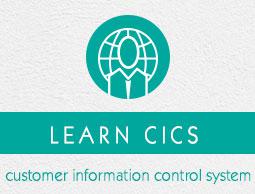CICS - Quick Guide
CICS - Overview
CICS is a DB/DC system which is used in online applications. CICS was developed because batch operating system can execute only batch programs. CICS programs can be written in COBOL, C, C++, Java, etc. These days, users want information within seconds and in real time. To provide such quick service, we need a system which can process information online. CICS allows users to communicate with the back-end system to get the desired information. Examples of online programs include online banking system, flight reservation, etc. Following image shows the components of CICS and how they are inter-related −
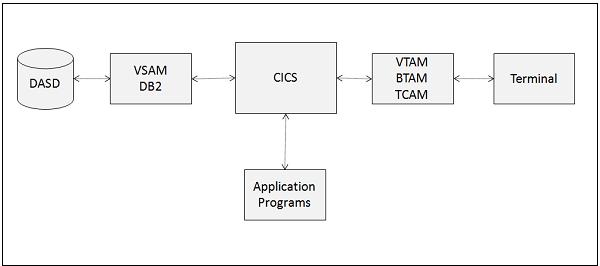
Functions of CICS
The main functions performed by CICS in an application are as follows −
CICS manages requests from concurrent users in an application.
Although, multiple users are working on CICS system but it gives a feel to user that he is the single user only.
CICS gives the access to data files for reading or updating them in an application.
Features of CICS
The features of CICS are as follows −
CICS is an operating system in itself, as it manages its own processor storage, has its own task manager which handles execution of multiple programs, and provides its own file management functions.
CICS provides online environment in batch operating system. Jobs submitted are executed immediately.
CICS is a generalized transaction processing interface.
It is possible to have two or more CICS regions at the same time, as CICS runs as a batch job in the operating system at the back-end.
CICS - Environment
CICS itself acts as an operating system. Its job is to provide an environment for online execution of application programs. CICS runs in one region or partition or address space. CICS handles scheduling for programs running under it. CICS runs as a batch job and we can view it in the spool by issuing the command PREFIX CICS*. There are five major services which are provided by CICS. All these services together perform a task.
CICS Environment
Following are the services which we will be discussing in detail step by step −
- System Services
- Data Communication Services
- Data Handling Services
- Application Programming Services
- Monitoring Services
- System Services
CICS maintains control functions to manage the allocation or de-allocation of resources within the system which are as follows −
Task Control − Task control provides task scheduling and multitasking features. It takes care of the status of all CICS tasks. Task Control allocates the processor time among concurrent CICS tasks. This is called multitasking. CICS tries to prioritize the response time to the most important task.
Program Control − Program Control manages loading and releasing of application programs. As soon as a task begins, it becomes necessary to associate the task with the appropriate application program. Although many tasks may need to use the same application program, CICS loads only one copy of the code into memory. Each task threads its way through this code independently, so many users can all be running transactions that are concurrently using the same physical copy of an application program.
Storage Control − Storage Control manages acquiring and releasing of main storage. Storage control acquires, controls, and frees dynamic storage. Dynamic storage is used for input/output areas, programs, etc.
Interval Control − Interval Control offers timer services.
Data Communication Services
Data Communication Services interface with telecommunication access methods such as BTAM, VTAM, and TCAM for handling data communication requests from application programs.
CICS releases application programs from the burden of dealing with terminal hardware issues through the use of Basic Mapping Support (BMS).
CICS provides Multi Region Operation (MRO) through which more than one CICS region in the same system can communicate.
CICS provides Inter System Communication (ISC) through which a CICS region in a system can communicate with the CICS region on another system.
Data Handling Services
Data Handling Services interface with data access methods such as BDAM, VSAM, etc.
CICS facilitates servicing of data handling requests from application programs. CICS provides application programmers a set of commands for dealing with data set and database access and related operations.
Data Handling Services interfaces with database access methods such as IMS/DB, DB2, etc. and facilitate servicing of database requests from application programs.
CICS facilitates management of data integrity by control of simultaneous record updates, protection of data as task ABENDs and protection of data at system failures.
Application Programming Services
Application Programming Services interface with application programs. The application programming services of CICS provide features such as command level translation, CEDF (the debug facility) and CECI (the command interpreter facility). We will be discussing more in detail in upcoming modules.
Monitoring Services
Monitoring Services monitor various events within CICS address space. It provides series of statistical information that can be used for system tuning.
CICS - Basic Terms
We must have knowledge of the basic terms used in CICS to get a better understanding of how it works. Application programs use CICS for communication with remote and local terminals and subsystems.
IBM 3270 Terminal
The 3270 Information Display System is a family of display and printer terminals. 3270 terminals were being used to connect to the mainframe via IBM controllers. Today, 3270 emulation software is available which means that even normal PCs can be used as 3270 terminals. 3270 terminals are dumb terminals and do not do any processing themselves. All processing needs to be done by the application program. IBM terminals consist of the following components −
CRT Monitor
The CRT monitor displays the output or the input fields of the application program. A screenshot of a 3278 Model of CRT monitor is shown below. It has the following characteristics −
It is capable of displaying 1920 characters.
Each of these 1920 character positions is individually addressable.
A COBOL application program can send data to all the positions on the screen.
The display characteristics like intensity, protected, non-protected of the field can be set using BMS which we will be discussing in detail in upcoming modules.
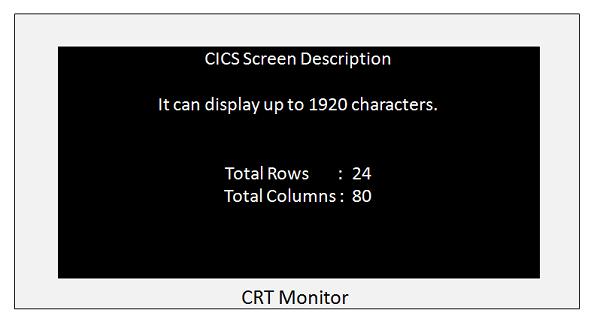
Keyboard
IBM keyboard keys are divided into following two categories −
Non-AID Keys − All other keys for alphabets, numeric, punctuation etc. are Non-Aid keys. When the user types text or numbers using non-aid keys, CICS will not even know if the user is typing anything or not.
AID Keys − AID keys are known as Attention Identifier Keys. CICS can detect only AID keys. After typing all the input, only when the user presses one of the AID keys, CICS takes control. AID Keys : ENTER, PF1 to PF24, PA1 to PA3, CLEAR. AID keys are further divided into two categories −
PF Keys − PF keys are known as function keys. PF keys allow transfer of data from terminal to CICS. PF Keys are ENTER and PF1 to PF24.
PA Keys − PA keys are known as Program Access keys. PA keys do not allow transfer of data between terminal and CICS. PA Keys are PA1 to PA3 and CLEAR.

Transaction
A CICS program is invoked through a transaction. A CICS transaction is a collection of logically related programs in an application. The whole application could be logically divided into several transactions.
Transaction identifiers which are 1 to 4 characters long are used to identify the transactions which the users want to do.
A programmer links one program to the transaction identifier which is used to invoke all the application programs for that particular transaction.
Task
A Task is a unit of work which is specific to a user.
Users invoke an application by using one of the transaction identifiers. CICS looks up for the transaction identifier to find out which program to invoke first to do the work requested. It creates a task to do the work, and transfers control to the mentioned program.
A transaction can be completed through several tasks.
A task can receive data from and send data to the terminal that started it. It can read and write files and can start other tasks also.
Task vs. Transaction
The difference between a transaction and a task is that several users can invoke a transaction but each user initiates his own task.
LUW
LUW stands for Logical Unit of Work. LUW states that a piece of work should be done completely or not done at all. A task can contain several Logical Unit of Works in CICS. We will discuss more about it in upcoming modules.
Application
An application is a series of logically grouped programs to form several transactions which is used to complete a specific task for the end-user.
a
CICS - Nucleus
The five CICS system components described earlier are a convenient grouping of CICS system programs, each of which performs its own specialized functions. The core of CICS known as the CICS Nucleus which consists of IBM-supplied CICS Control Programs and Control Tables.
Control Programs
CICS nucleus is constructed by the control programs and corresponding control tables. It provides unique advantages. It makes the CICS system highly flexible and thus easy to maintain. Following are the important control programs of CICS −
TCP
TCP is known as Terminal Control Program.
TCP is used to receive messages from the terminal.
It maintains hardware communication requirements.
It requests CICS to initiate the tasks.
KCP
KCP is known as Task Control Program.
PCP
PCP is known as Program Control Program.
PCP is used to locate and load programs for execution.
It transfers the control between programs and in the end, it returns the control back to the CICS.
FCP
FCP is known as File Control Program.
FCP is used to provide application programs with services like read, insert, update or delete records in a file.
It keeps exclusive control over the records in order to maintain data integrity during record updates.
SCP
SCP is known as Storage Control Program. It is used to control allocation and deallocation of storage within a CICS region.
Control Tables
CICS consists of IBM-supplied CICS control programs and tables. These tables need to be updated accordingly with the application information for successful execution of CICS application programs. Following are the important Control Tables −
TCT
TCT is known as Terminal Control Table.
When we login to a CICS terminal, an entry is made in the TCT table.
TCT contains the terminal ID's that are connected to current CICS region.
Terminal Control Program along with terminal control table recognize the incoming data from the terminal.
PCT
PCT is known as Program Control Table.
PPT
PPT is known as Processing Program Table. PPT contains Program name or Mapset name, Task Use Counter, Language, Size, Main storage address, Load library address, etc.
Program or Mapset name is unique in a PPT table.
CICS receives the transaction and a corresponding program name is allocated to the transaction from the PCT. It checks if the program is loaded or not. If it is loaded, then the task use counter is increased by 1. If the program is not loaded, then the program is first loaded and the task use counter is set to 1. It gets the load library address from the PPT table.
FCT
FCT is known as File Control Table.
It contains File names, File type, record length, etc.
All the files used in a CICS program must be declared in FCT and they are opened and closed by CICS itself.
Transaction
When a transaction identifier TP02 is entered on the CICS terminal, first it checks if there is a program associated with this Transaction identifier in the PCT table. If it finds one, then it checks in the PPT table to find the location of the Program to execute it.
If the program is already available in the memory, it starts executing that particular program; if not, it loads the program to the memory from the secondary storage and then starts executing it.
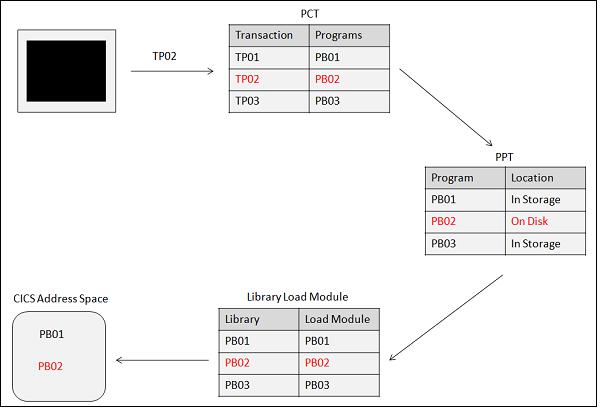
Transaction Life Cycle
The transaction life cycle has the following steps −
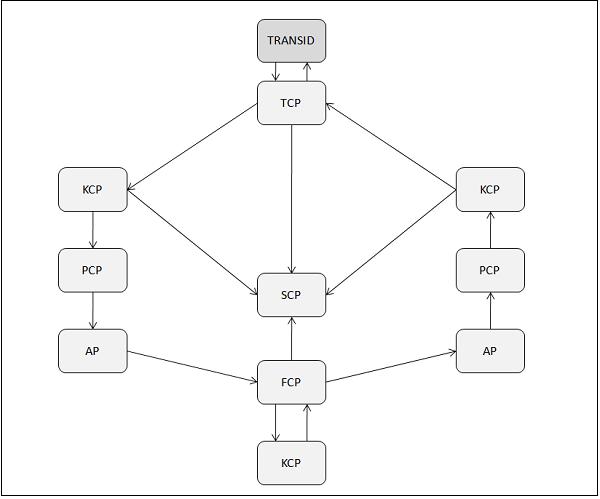
Step 1
The terminal operator initiates the transaction by typing a 1 to 4 character transaction-id and pressing the ENTER key.
Step 2
The TCP periodically checks all the terminals for input. When a message is received, it does the following −
Instructs the SCP to create a TIOA.
Places the message in the TIOA.
Passes the control to the KCP.
Step 3
The KCP takes control from the TCP and does the following −
Validates the transaction-id and security.
Instructs the SCP to create a task control area.
Assigns priority to the task based on Terminal priority (Set in TCT), Operator priority (Set in SNT), and Transaction priority (Set in PCT).
Adds the task to the queue of waiting programs.
Dispatches waiting programs in the order of priority.
Passes the control to the PCP.
Step 4
The PCP takes control from the KCP and does the following −
Step 5
The Application program takes control from the PCP and does the following −
Step 6
The FCP takes control from the Application program and does the following −
Step 7
The KCP does the following −
Dispatches the next task in the queue.
Re-dispatches the old task when I/O is complete.
Transfers the control to the FCP.
Step 8
The FCP returns control to the Application program.
Step 9
The Application program does the following −
Step 10
The PCP returns the control back to the KCP requesting it to end the task.
Step 11
The KCP instructs the SCP to free all the storage allocated to the task (except TIOA).
Step 12
The TCP does the following −
CICS - Transactions
CICS transactions are used to perform multiple operations in the CICS region. We will be discussing the important CICS transactions supplied by IBM in detail.
CESN
CESN is known as CICS Execute Sign On.
CESN is used to Sign on to the CICS region.
We need to provide the User-Id and Password given by the CICS administrator to log on to CICS. The following screenshot shows how the sign-on screen looks like −

CEDA
CEDA is known as CICS Execute Definition and Administration. It is used by CICS System Administrators to define CICS table entries and other administration activities.
CEMT
CEMT is known as CICS Execute Master Terminal. It is used to inquire and update the status of CICS environments and also for other system operations.
Using CEMT command, we can manage transactions, tasks, files, programs, etc.
To get all the possible options, type CEMT and press ENTER. It will display all the options.
CEMT is basically used for loading a new program into the CICS or for loading a new copy of the program into the CICS after the program or mapset is changed.
Example
One can overwrite the status of the file displayed to change it. Following example shows how to close a file −
CEMT
** Press ENTER & Following Screen is displayed **
STATUS: ENTER ONE OF THE FOLLOWING
Inquire
Perform
Set
** Command to close a file **
CEMT SET FILE (file-name)
CEMT I FILE (file-name)
CECI
CECI is known as CICS Execute Command Interpreter. Many CICS commands can be executed using CECI.
CECI is used to check the syntax of the command. It executes the command, only if the syntax is correct.
Type the CECI option on the empty CICS screen after having logged in. It gives you the list of options available.
Example
Following example shows how to send mapped output data to terminal. We will be discussing about MAPS in the upcoming modules.
CECI SEND MAP (map-name) MAPSET (mapset-name) ERASE
CEDF
CEDF is known as CICS Execute Debug Facility. It is used for debugging the program step by step, which helps in finding the errors.
Type CEDF and press enter in the CICS region. The terminal is in EDF mode message will be displayed. Now type the transaction id and press the enter key. After initiation, with each enter key, a line is executed. Before executing any CICS command, it shows the screen in which we can modify the values before proceeding further.
CMAC
CMAC is known as CICS Messages for Abend Codes. It is used to find the explanation and reasons for CICS Abend Codes.
Example
Following example shows how to check details for an Abend code −
CMAC abend-code
CESF
CESF is known as CICS Execute Sign Off. It is used to Sign Off from the CICS region.
Example
Following example shows how to log off from the CICS region −
CESF LOGOFF
CEBR
CEBR is known as CICS Execute Temporary storage Browse. It is used to display contents of a temporary storage queue or TSQ.
CEBR is used while debugging to check if the items of the queue are being written and retrieved properly. We will discuss more about TSQ in the upcoming modules.
Example
Following example shows how to invoke the CEBR command −
CEBR queue-id
CICS Concepts
Each command could be achieved by executing a series of CICS macros. We will discuss some basic features which will help us understand the concepts better −
Multitasking
This feature of operating system allows more than one task to be executed concurrently. The task may be sharing the same program or using different programs. The CICS schedules the task in its own region.
Multi-threading
This feature of the operating system allows more than one task to be executed concurrently sharing the same program. For multi-threading to be possible, an application program should be a re-entrant program under the operating system or a quasi-reentrant under the CICS.
Re-entrancy
A re-entrant program is one which does not modify itself and can re-enter in itself and continue processing after an interruption by the operating system.
Quasi-reentrancy
A quasi-reentrant program is a re-entrant program under CICS environment. CICS ensures re-entrancy by acquiring a unique storage area for each task. Between CICS commands, the CICS has the exclusive right to use the CPU resources and it can execute other CICS commands of other tasks.
There are times when many users are concurrently using the same program; this is what we call multi-threading. For example, let’s suppose 50 users are using a program A. Here the CICS will provide 50 working storage for that program but one Procedure Division. And this technique is known as quasi-reentrancy.
CICS - COBOL Basics
CICS programs are written in COBOL language in Mainframes. We will be discussing about writing a simple COBOL-CICS program, compiling it, and then executing it.
CICS Program
We will be writing a simple COBOL-CICS program which displays some message on the CICS output screen. This program is to demonstrate the steps involved in executing a COBOL-CICS program. Following are the steps to code a simple program −
Step 1
Login to Mainframes and open a TSO Session.
Step 2
Create a new PDS in which we will be coding our program.
Step 3
Create a new member inside the PDS and code the following program −
IDENTIFICATION DIVISION.
PROGRAM-ID. HELLO.
DATA DIVISION.
FILE SECTION.
WORKING-STORAGE SECTION.
01 WS-MESSAGE PIC X(40).
01 WS-LENGTH PIC S9(4) COMP.
PROCEDURE DIVISION.
A000-MAIN-PARA.
MOVE 'Hello World' TO WS-MESSAGE
MOVE '+12' TO WS-LENGTH
EXEC CICS SEND TEXT
FROM (WS-MESSAGE)
LENGHT(WS-LENGTH)
END-EXEC
EXEC CICS RETURN
END-EXEC.
Step 4
After coding the program, we need to compile it. We can compile the program using the following JCL −
//SAMPLE JOB(TESTJCL,XXXXXX),CLASS = A,MSGCLASS = C
//CICSCOB EXEC CICSCOB,
//COPYLIB = ABC.XYZ.COPYLIB,
//LOADLIB = ABC.XYZ.LOADLIB
//LIB JCLLIB ORDER = CICSXXX.CICS.XXXPROC
//CPLSTP EXEC DFHEITVL
//TRN.SYSIN DD DSN = ABC.XYZ.PDS(HELLO),DISP = SHR
//LKED.SYSIN DD *
NAME HELLO(R)
//
Step 5
Open a CICS session.
Step 6
We will now install the program using the following command −
CEMT SET PROG(HELLO) NEW.
Step 7
Execute the program using the associated transaction-id. Transaction-id is provided by the Administrator. It will show the following output −
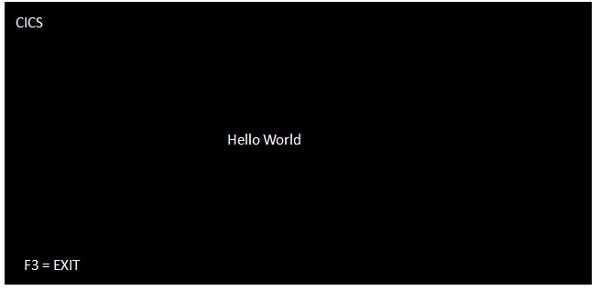
Program Compilation
The following flowchart shows the steps used in compiling a COBOL-CICS program −

Translator
The function of a translator is to check for syntax errors in CICS commands. It translates them into equivalent COBOL statements.
Compiler
The function of a compiler is to expand the COBOL copy books. It compiles the code after checking the source code for syntax errors.
Linkage Editor
The function of a Linkage Editor is to link different object modules to create a single load module.
CICS - BMS
BMS is known as Basic Mapping Support. An application consists of formatted screens which act as a bridge between the terminal and the CICS programs. For communication to occur between the terminal and the CICS programs, we use CICS terminal input/output services. We use BMS to create screen designs with proper positions and attributes. Following are the functions of BMS −
BMS acts as an interface between the terminal and the CICS programs.
The design and format of the screen is separate from the logic of application.
BMS makes the application hardware independent.
Formatted Screen
The screen shown below is a Menu Screen and can be designed using BMS. Its key points are as follows −
The screen could have a Title, date, and any other information that is to be displayed.
The Option 1, 2, and 3 are the Unnamed fields which are the titles of the screen.
In the Selection field, we need to provide the input. This input is then sent to the CICS program for further processing.
At the bottom of the screen, Action keys are displayed.
All the fields and the screen itself is defined with BMS macros. When the whole map is defined, we can use JCL to assemble it.
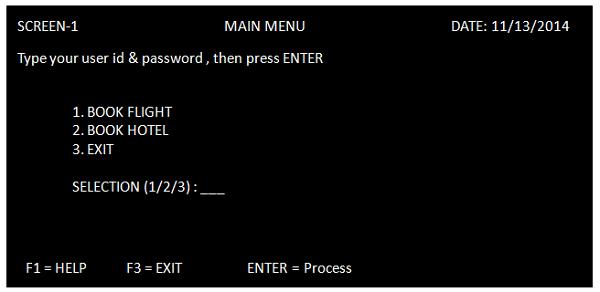
BMS Basic Terms
Following are the basic terms which we will be using in the upcoming modules −
Map
Map is a single screen format which can be designed using BMS macros. It can have names containing 1 to 7 chars.
Mapset
Mapset is a collection of maps which are linked together to form a load module. It should have a PPT entry. It can have names from 1 to 7 chars.
BMS Macros
BMS map is a program which is written in Assembly language to manage screens. The three macros that are used to define the screen are DFHMSD, DFHMDI, and DFHMDF.
DFHMSD
DFHMSD macro generates Mapset definition. It is macro identifier which shows that we are starting a mapset. The mapset name is the load module name and an entry in PPT table must be present. The following table shows the list of parameters which can be used in DFHMSD −
| Sr.No |
Parameter & Description |
| 1 |
TYPE
TYPE is used to define the map type. If TYPE =
MAP - Physical map is created
DSECT - Symbolic map is created
&&SYSPARM - Physical & Symbolic, both are created
FINAL - To indicate the end of a mapset coding. |
| 2 |
MODE
MODE is used to indicate input/output operations. IF MODE =
IN - For an input map only
OUT - For an output map only
INOUT For both input & output map
|
| 3 |
LANG
LANG = ASM/COBOL/PL1
It decides the language of the DSECT structure, for copying into the application program. |
| 4 |
STORAGE
If STORAGE =
AUTO - To acquire a separate symbolic map area for each mapset
BASE - To have the same storage base for the symbolic maps of from more than one mapset |
| 5 |
CTRL
CRTL is used to define the device control requests. If CTRL =
FREEKB - To unlock the keyboard
FRSET - To reset MDT to zero status
ALARM - To set an alarm at screen display time
PRINT - To indicate the mapset to be sent to the printer.
|
| 6 |
TERM
TERM = type ensures device independence,required if other than 3270 terminal is being used. |
| 7 |
TIOAPFX
TIOAPFX = YES/NO
YES - To reserve the prefix space (12 bytes) for BMS commands to access TIOA properly. Required for the CICS command level.
|
Example
The following example shows how to code a mapset definition −
MPST01 DFHMSD TYPE = &SYSPARM, X
CTRL = (FREEKB,FRSET), X
LANG = COBOL, X
STORAGE = AUTO, X
TIOAPFX = YES, X
MODE = INOUT, X
TERM = 3270
DFHMSD TYPE = FINAL
END
DFHMDI
DFHMDI macro generates map definitions. It shows that we are starting a new map. Mapname is followed by the DFHMDI macro. Mapname is used to send or receive maps. The following table shows the parameters which we use inside a DFHMDI macro −
| Sr.No |
Parameter & Description |
| 1 |
SIZE
SIZE = (Line,Column)
This parameter gives the size of the map. BMS allows us to build a screen using several maps, and this parameter becomes important when we are using more than one maps in a single mapset. |
| 2 |
LINE
It indicates the starting line number of the map. |
| 3 |
COLUMN
It indicates the starting column number of the map.
|
| 4 |
JUSTIFY
It is used to specify the entire map or the map fields to be left or right justified.
|
| 5 |
CTRL
CRTL is used to define the device control requests. If CTRL =
FREEKB - To unlock the keyboard
FRSET - To reset MDT to zero status
ALARM - To set an alarm at screen display time
PRINT - To indicate the map to be sent to the printer
|
| 6 |
TIOAPFX
TIOAPFX = YES/NO
YES - To reserve the prefix space (12 bytes) for BMS commands to access TIOA properly. Required for the CICS command level.
|
Example
The following example shows how to code a map definition −
MAPSTD DFHMDI SIZE = (20,80), X
LINE = 01, X
COLUMN = 01, X
CTRL = (FREEKB,FRSET)
DFHMDF
DFHMDF macro is used to define field names. The field name is mentioned against which DFHMDF macro is coded. This field name is used inside the program. We do not write field name against constant field which we do not want to use inside the program. The following table shows the list of parameters which can be used inside a DFHMDF macro −
| Sr.No |
Parameter & Description |
| 1 |
POS
This is the position on the screen where the field should appear. A field starts with its attribute byte, so if you code POS = (1,1), the attribute byte for that field is on line 1 in column 1, and the actual data starts in column 2.
|
| 2 |
LENGTH
This is the length of the field, not counting the attribute byte.
|
| 3 |
INITIAL
This is the character data for an output field. We use this to specify labels and titles for the screen and keep them independent of the program. For the first field in the menu screen, for example, we will code: INITIAL = 'MENU'.
|
| 4 |
JUSTIFY
It is used to specify the entire map or the map fields to be left or right justified.
|
| 5 |
ATTRB
ATTRB = (ASKIP/PROT/UNPROT, NUM, BRT/NORM/DRK, IC, FSET) It describes the attributes of the field.
ASKIP - Autoskip. Data cannot be entered in this field. The cursor skips to the next field.
PROT - Protected field. Data cannot be entered into this field. If data is entered, it will cause the input-inhibit status.
UNPROT - Unprotected field. Data can be entered and this is used for all input fields.
NUM - Numeric field. Only numbers (0 to 9) and special characters('.' and '-') are allowed.
BRT - Bright display of a field (highlight).
NORM - Normal display.
DRK - Dark display.
IC - Insert cursor. The cursor will be positioned in this field. In case, IC is specified more than once, the cursor is placed in the last field.
FSET - Field set. MDT is set on so that the field data is to be sent from the terminal to the host computer regardless of whether the field is actually modified by the user.
|
| 6 |
PICIN
PICIN applies to the data field which is used as input like PICIN = 9(8). |
| 7 |
PICOUT
PICIN applies to the data field which is used as output like PICOUT = Z(8).
|
Example
The following example shows how to code a field definition −
DFHMDF POS = (01,01), X
LENGTH = 7, X
INITIAL = ‘SCREEN1’, X
ATTRB = (PROT,NORM)
STDID DFHMDF POS = (01,70), X
LENGTH = 08, X
ATTRB = (PROT,NORM)
CICS - MAP
BMS receives the data entered by the user and then formats it into a symbolic map area. The application program has access only to the data present in the symbolic map. The application program processes the data and the output is sent to the symbolic map. BMS will merge the output of the symbolic data with the physical map.
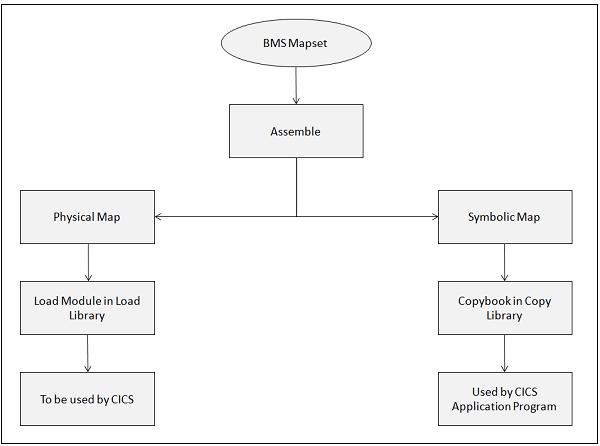
Physical Map
Physical Map is a load module in the load library which contains information about how the map should be displayed.
It contains the details about the attributes of all the fields in the map and their positions.
It contains the display format of the map for a given terminal.
It is coded using BMS macros. It is assembled separately and link edited into the CICS library.
Symbolic Map
A Symbolic Map is a Copy book in the library. The Copy book is used by the CICS application program to send and receive data from the terminal.
Skipper and Stopper Field
For an unprotected named field, in a map, if we have specified a length of 10, this means that the name field can take values whose length cannot exceed 10. But when you display this map using CICS and start entering values for this field on the screen, we can enter more than 10 Characters, i.e., till the end of the screen and we can enter even in the next line. To prevent this, we use Skipper field or stopper field. A Skipper field would generally be an Unnamed field of length 1, specified after a named field.
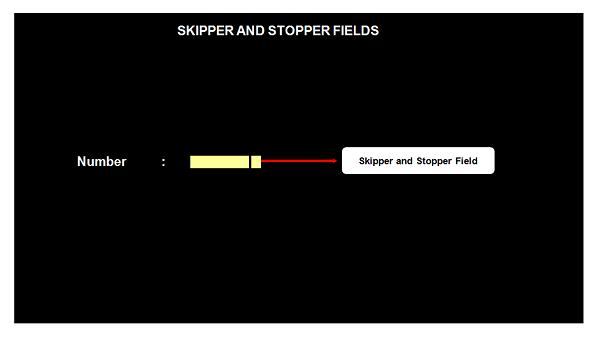
Skipper Field
If we place a skipper field after the named unprotected field, then while entering the value, once the specified length is reached, the cursor will automatically position to the next unprotected field. The following example shows how to add a skipper field −
NUMBER DFHMDF POS = (01,01), X
LENGTH = 5, X
ATTRB = (UNPROT,IC)
DFHMDF POS = (01,07), X
LENGTH = 1, X
ATTRB = (ASKIP)
Stopper Field
If we place a stopper field after the named unprotected field, then while entering the value, once the specified length is reached, the cursor will stop its positioning. The following example shows how to add a stopper field −
NUMBER DFHMDF POS = (01,01), X
LENGTH = 5, X
ATTRB = (UNPROT,IC)
DFHMDF POS = (01,07), X
LENGTH = 1, X
ATTRB = (PROT)
Attribute Byte
The attribute byte of any field stores information about the physical properties of the field. The following diagram and the table explain the significance of each bit.

| Bit Position |
Description |
Bit Settings |
| 0 & 1 |
|
Determined by contents of bit 2 to 7 |
| 2 & 3 |
Protection & Shift |
00 - Unprotected Alphanumeric
01 - Unprotected Numeric
10 - Protected Stop
11 - Protected Skip |
| 4 & 5 |
Intensity |
00 - Normal
01 - Normal
10 - Bright
11 - No-display ( Dark ) |
| 6 |
|
Must be Zero Always |
| 7 |
Modified Data Tag |
0 - Field has not been modified
1 - Field has been modified |
Modified Data Tag
Modified Data Tag (MDT) is the last bit in the attribute byte.
MDT is a flag which holds a single bit. It specifies whether the value is to be transferred to the system or not.
Its default value is 1, when the field value is changed.
If MDT is 0, then data cannot be transferred; and if MDT is 1, then data can be transferred.
Send Map
The send map command writes formatted output to the terminal. It is used to send the map to the terminal from the application program. The following code segment shows how to send a map to the terminal −
EXEC CICS SEND
MAP('map-name')
MAPSET('mapset-name')
[FROM(data-area)]
[LENGTH(data_value)]
[DATAONLY]
[MAPONLY]
[CURSOR]
[ERASE/ERASEAUP]
[FREEKB]
[FRSET]
END-EXEC
The following table lists the parameters used in a send map command along with their significance.
| Sr.No |
Parameter & Description |
| 1 |
Map-name
It is the name of the map which we want to send. It is mandatory. |
| 2 |
Mapset-name
It is the name of the map set that contains the mapname. The mapset name is needed unless it is the same as the map name. |
| 3 |
FROM
It is used if we have decided to use a different DSECT name, we must use the option FROM (dsect-name) along with SEND MAP command. |
| 4 |
MAPONLY
It means that no data from your program is to be merged into the map and only the information in the map is transmitted. |
| 5 |
DATAONLY
It is the logical opposite of MAPONLY. We use it to modify the variable data in a display that has already been created. Only the data from your program is sent to the screen. The constants in the map are not sent. |
| 6 |
ERASE
It causes the entire screen to be erased before what we are sending is shown. |
| 7 |
ERASEUP
It causes only unprotected fields to be erased. |
| 8 |
FRSET
Flag Reset turns off the modified data tag in the attribute byte for all the fields on the screen before what you are sending is placed there. |
| 9 |
CURSOR
It can be used to position the cursor on the terminal screen. Cursor can be set by moving -1 to the L part of the field and then sending the map. |
| 10 |
ALARM
It causes the audible alarm to be sounded. |
| 11 |
FREEKB.
The keyboard is unlocked if we specify FREEKB in either the map or the SEND command. |
| 12 |
PRINT
It allows the output of a SEND command to be printed on a printer. |
| 13 |
FORMFEED
It causes the printer to restore the paper to the top of the next page before the output is printed. |
Receive Map
When we want to receive input from a terminal, we use the RECEIVE MAP command. The MAP and MAPSET parameters have exactly the same meaning as for the SEND MAP command. The following code segment shows how to receive a map −
EXEC CICS RECEIVE
MAP('map-name')
MAPSET('mapset-name')
[INTO(data-area)]
[FROM(data-area)]
[LENGTH(data_value)]
END-EXEC
Mapset Execution
The following steps are necessary to develop and execute a mapset −
Step 1 − Open a TSO session.
Step 2 − Create a new PDS.
Step 3 − Code a mapset in a new member according to the requirement.
Step 4 − Assemble the mapset using the JCL provided by the CICS administrator.
Step 5 − Open a CICS Session.
Step 6 − Install the program using the command −
CEMT SET PROG(mapset-name) NEW
Step 7 − Type the following command to send the Map to the terminal −
CECI SEND MAP(map-name) MAPSET(mapset-name) ERASE FREEKB
CICS - Interface Block
Any application program would require an interface to interact with the CICS. EIB (Execute Interface Block) acts as an interface to allow application programs communicate with the CICS. EIB contains the information required during the execution of a program.
Restricted COBOL Verbs
While coding a CICS program, we cannot use the commands which return the control directly to the MVS. If we code these COBOL verbs, it will not give any compilation error, but we may get unpredictable results. Following are the COBOL verbs which should not be used in a CICS program −
File I/O statements like Open, Read, Write, Rewrite, Close, Delete, and Start. All file I/O in CICS is handled by the file control module and they have their own set of statements like READ, WRITE, REWRITE, and DELETE which we will be discussing in the upcoming modules.
File Section and Environment Division is not required.
COBOL statements that invoke operating system functions like Accept, Date/Time cannot be used.
Do not use DISPLAY, MERGE, STOP RUN, and GO BACK.
Execute Interface Block
Execute Interface Block (EIB) is a control block which is loaded automatically by the CICS for every program.
The EIB is unique to a task and it exists for the duration of the task. It contains a set of system related information corresponding to the task.
It contains information about transaction identifier, time, date, etc., which is used by the CICS during the execution of an application program.
Every program that executes as a part of the task has access to the same EIB.
The data in EIB at runtime can be viewed by executing the program in CEDF mode.
EIB Fields
The following table provides a list of fields which are present in EIB −
| EIB Field |
PIC Clause |
Description |
| EIBAID |
X(1) |
Aid key Pressed |
| EIBCALEN |
S9(4) COMP |
It contains length of DFHCOMMAREA |
| EIBDATE |
S9(7) COMP-3 |
It contains Current System Date |
| EIBRCODE |
X(6) |
It contains Return code of the last transaction |
| EIBTASKN |
S9(7) COMP-3 |
It contains Task number |
| EIBTIME |
S9(7) COMP-3 |
It contains Current System Time |
| EIBTRMID |
X(4) |
Terminal Identifier |
| EIBTRNID |
X(4) |
Transaction Identifier |
CICS Programs Classification
CICS Programs are classified in the following three categories which we will discuss one by one −
- Non-Conversational Programs
- Conversational Programs
- Pseudo-Conversational Programs - We will discuss in the next module
Non Conversational Programs
While executing non-conversational programs, no human intervention is required. All the necessary inputs are provided when the program is started.
They are similar to batch programs that run in the batch mode. So in CICS, they are rarely developed.
We can say they are used just for displaying a sequence of screens at regular intervals of time.
Example
The following example shows a non-conversational program which will simply display "HELLO WORLD" on the CICS terminal as output −
IDENTIFICATION DIVISION.
PROGRAM-ID. HELLO.
DATA DIVISION.
WORKING-STORAGE SECTION.
01 WS-MESSAGE PIC X(30).
PROCEDURE DIVISION.
********************************************************
* SENDING DATA TO SCREEN *
********************************************************
MOVE 'HELLO WORLD' TO WS-MESSAGE
EXEC CICS SEND TEXT
FROM (WS-MESSAGE)
END-EXEC
********************************************************
* TASK TERMINATES WITHOUT ANY INTERACTION FROM THE USER*
********************************************************
EXEC CICS RETURN
END-EXEC.
Conversational Program
Sending a message to the terminal and receiving a response from the user is called a conversation. An online application achieves a conversation between the user and the application program by a pair of SEND and RECEIVE command. The key points of a Conversational program are as follows −
The system sends a message to the screen and waits for the user’s response.
The time taken by user to respond is known as Think Time. This time is considerably high, which is a major drawback of Conversational programs.
The user provides the necessary input and presses an AID key.
The application processes the user’s input and sends the output.
The program is loaded into the main storage at the beginning and is retained till the task ends.
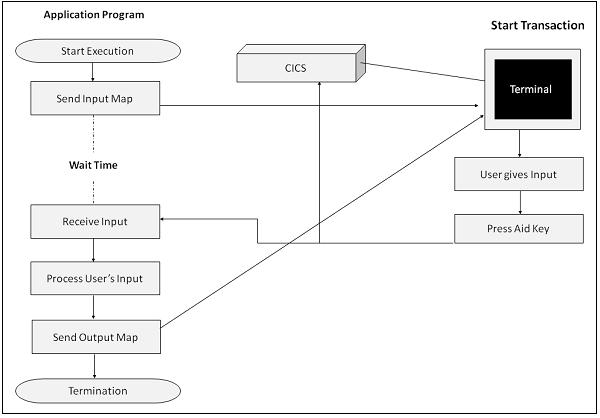
Example
The following example shows a conversion program which takes input from the user and then simply displays the same input on the CICS terminal as output −
IDENTIFICATION DIVISION.
PROGRAM-ID. HELLO.
DATA DIVISION.
WORKING-STORAGE SECTION.
01 WS-MESSAGE PIC X(30) VALUE SPACES.
PROCEDURE DIVISION.
MOVE 'ENTER MESSAGE' TO WS-MESSAGE
********************************************************
* SENDING DATA FROM PROGRAM TO SCREEN *
********************************************************
EXEC CICS SEND TEXT
FROM (WS-MESSAGE)
END-EXEC
********************************************************
* GETTING INPUT FROM USER *
********************************************************
EXEC CICS RECEIVE
INTO(WS-MESSAGE)
END-EXEC
EXEC CICS SEND TEXT
FROM (WS-MESSAGE)
END-EXEC
********************************************************
* COMMAND TO TERMINATE THE TRANSACTION *
********************************************************
EXEC CICS RETURN
END-EXEC.
CICS - Pseudo Programming
As of now, we have covered non-conversion and conversion programs. Conversion programs have a major drawback as their think time is considerably high. To overcome this problem, pseudo-conversion programming came into the picture. We will now discuss more about pseudo-conversion programs.
Pseudo-Conversion Program
Following is the sequence of events which take place in a pseudo-conversion program −
Step 1 − The system sends a message to the screen and terminates the transaction, specifying the transaction to be started when the user input is received.
Step 2 − The system allocates the resources used by this transaction to other transactions running in the system. So we can utilize the resources in a pseudo-conversion program till the user gives the input.
Step 3 − The system polls the terminal input at regular intervals of time. When the input is received, it is processed and the output is displayed.
Step 4 − The application program is loaded into the main storage when needed and released when not in use.

Pseudo Conversion Techniques
The important point to note in pseudo-conversation is passing of data between every task. We will discuss about the techniques for passing data.
COMMAREA
COMMAREA is known as communication area. COMMAREA is used to pass data between tasks. The following example shows how to pass COMMAREA where WSCOMMAREA and WS-COMMAREA-LENGTH are declared in Working Storage Section −
EXEC CICS RETURN
TRANSID ('transaction-id')
COMMAREA (WS-COMMAREA)
LENGTH (WS-COMMAREA-LENGTH)
END-EXEC.
DFHCOMMAREA
DFHCOMMAREA is a special memory area which is provided by CICS to every task.
It is used to pass data from one program to another program. The programs can exist in the same transaction or in different transaction also.
It is declared in the Linkage Section of the program at 01 level.
It should have the same picture clause as WS-COMMAREA.
Data can be moved back from DFHCOMMAREA to WS-COMMAREA using a MOVE statement.
MOVE DFHCOMMAREA TO WS-COMMAREA.
Example
After sending the map, the task ends and waits for the user response. At this stage, the data needs to be saved, because though the task has ended, the transaction has not. When this transaction is to be resumed, it would require the prior status of the task. User enters the input. This now has to be received by the RECEIVE MAP command and then validated. The following example shows how to declare COMMAREA and DFHCOMMAREA −
WORKING-STORAGE SECTION.
01 WS-COMMAREA.
05 WS-DATA PIC X(10).
LINKAGE SECTION.
01 DFHCOMMAREA.
05 LK-DATA PIC X(10).
Pseudo Code
Given below is the logic of pseudo code which we use in pseudo programming −
MOVE DFHCOMMAREA TO WS-COMMAREA
IF EIBCALEN = 0
STEP1: SEND MAP
STEP2: MOVE <internal-transaction-id1> to WS-COMMAREA
STEP3: ISSUE CONDITIONAL RETURN
ELSE
IF WS-COMMAREA = <internal-transaction-id1>
STEP4: RECEIVE MAP
STEP5: PROCESS DATA
STEP6: SEND OUTPUT MAP
STEP7: MOVE <internal-transaction-ID2> to WS-COMMAREA
STEP8: ISSUE CONDITIONAL RETURN
END-IF
END-IF
STEP9: REPEAT STEP3 TO STEP7 UNTIL EXIT
Example
The following example shows a pseudo-conversion program −
******************************************************************
* PROGRAM TO DEMONSTRATE PSEUDO-CONVERSATION *
******************************************************************
IDENTIFICATION DIVISION.
PROGRAM-ID. HELLO.
DATA DIVISION.
WORKING-STORAGE SECTION.
01 WS-MESSAGE PIC X(30).
01 WS-COMMAREA PIC X(10) VALUE SPACES.
LINKAGE SECTION.
01 DFHCOMMAREA PIC X(10).
PROCEDURE DIVISION.
MOVE DFHCOMMAREA TO WS-COMMAREA
IF WS-COMMAREA = SPACES
******************************************************************
* TRANSACTION GETTING EXECUTED FOR THE FIRST TIME *
******************************************************************
MOVE 'HELLO' TO WS-MESSAGE
EXEC CICS SEND TEXT
FROM (WS-MESSAGE)
END-EXEC
MOVE 'FIRST' TO WS-COMMAREA
******************************************************************
* TASK ENDS AS A RESULT OF RETURN. IF AID KEY PRESSED, NEXT *
* TRANSACTION SHOULD BE TP002. DATA PASSED FROM WS-COMMAREA TO *
* DFHCOMMAREA *
******************************************************************
EXEC CICS RETURN
TRANSID('TP002')
COMMAREA(WS-COMMAREA)
END-EXEC
******************************************************************
* IF COMMAREA IS NOT EMPTY , THEN TP002 HAS BEEN EXECUTED ONCE *
* ALREADY, USER INTERACTION IS FACILITATED BY RECEIVE *
******************************************************************
ELSE
EXEC CICS RECEIVE
INTO(WS-MESSAGE)
END-EXEC
EXEC CICS SEND TEXT
FROM (WS-MESSAGE)
END-EXEC
******************************************************************
* TASK ENDS AS A RESULT OF RETURN, NO NEXT TRANSACTION SPECIFIED *
* TO BE EXECUTED *
******************************************************************
EXEC CICS RETURN
END-EXEC
END-IF.
Advantages of Pseudo Conversion
Following are the advantages of pseudo conversion −
The resources are best utilized. Resources are released as soon as the program is suspended temporarily.
It looks as if it is in conversational mode.
It has better response time.
Return Statements
Following are the two types of return statements which are used in CICS −
Return-1
When the following unconditional return statement is issued, the task and the transaction (program) is terminated.
EXEC CICS RETURN
END-EXEC.
Return-2
When the following conditional return, i.e., return with TRANSID statement is issued, the control returns to the CICS with the next transid to be executed. The next transaction starts when the user presses an AID key.
EXEC CICS RETURN
TRANSID ('trans-id')
[COMMAREA(WS-COMMAREA)]
END-EXEC.
CICS - Aid Keys
As we have discussed in earlier modules, AID keys are known as Attention Identifier Keys. CICS can detect only AID keys. After typing all the input, only when the user presses one of the AID keys, the CICS takes control. AID Keys include ENTER, PF1 to PF24, PA1 to PA3, and CLEAR.
Validating AID keys
The key pressed by the user is checked by using EIBAID.
EIBAID is one byte long and holds the actual attention identifier value used in the 3270 input stream.
CICS provides us with a pre-coded set of variables which can be used in the application program by writing the following statement −
COPY DFHAID
DFHAID
DFHAID is a copybook which is used in application programs to include CICS pre-coded set of variables. The following content is present in the DFHAID copybook −
01 DFHAID.
02 DFHNULL PIC X VALUE IS ' '.
02 DFHENTER PIC X VALUE IS ''''.
02 DFHCLEAR PIC X VALUE IS '_'.
02 DFHCLRP PIC X VALUE IS '¦'.
02 DFHPEN PIC X VALUE IS '='.
02 DFHOPID PIC X VALUE IS 'W'.
02 DFHMSRE PIC X VALUE IS 'X'.
02 DFHSTRF PIC X VALUE IS 'h'.
02 DFHTRIG PIC X VALUE IS '"'.
02 DFHPA1 PIC X VALUE IS '%'.
02 DFHPA2 PIC X VALUE IS '>'.
02 DFHPA3 PIC X VALUE IS ','.
02 DFHPF1 PIC X VALUE IS '1'.
02 DFHPF2 PIC X VALUE IS '2'.
02 DFHPF3 PIC X VALUE IS '3'.
02 DFHPF4 PIC X VALUE IS '4'.
02 DFHPF5 PIC X VALUE IS '5'.
02 DFHPF6 PIC X VALUE IS '6'.
02 DFHPF7 PIC X VALUE IS '7'.
02 DFHPF8 PIC X VALUE IS '8'.
02 DFHPF9 PIC X VALUE IS '9'.
02 DFHPF10 PIC X VALUE IS ':'.
02 DFHPF11 PIC X VALUE IS '#'.
02 DFHPF12 PIC X VALUE IS '@'.
02 DFHPF13 PIC X VALUE IS 'A'.
02 DFHPF14 PIC X VALUE IS 'B'.
02 DFHPF15 PIC X VALUE IS 'C'.
02 DFHPF16 PIC X VALUE IS 'D'.
02 DFHPF17 PIC X VALUE IS 'E'.
02 DFHPF18 PIC X VALUE IS 'F'.
02 DFHPF19 PIC X VALUE IS 'G'.
02 DFHPF20 PIC X VALUE IS 'H'.
02 DFHPF21 PIC X VALUE IS 'I'.
02 DFHPF22 PIC X VALUE IS '¢'.
02 DFHPF23 PIC X VALUE IS '.'.
02 DFHPF24 PIC X VALUE IS '<'.
Example
The following example shows how to use DFHAID copybook in an application program −
IDENTIFICATION DIVISION.
PROGRAM-ID. HELLO.
DATA DIVISION.
WORKING-STORAGE SECTION.
COPY DFHAID.
PROCEDURE DIVISION.
A000-AIDKEY-PARA.
EVALUATE EIBAID
WHEN DFHAID
PERFORM A000-PROCES-PARA
WHEN DFHPF1
PERFORM A001-HELP-PARA
WHEN DFHPF3
PERFORM A001-EXIT-PARA
END-EVALUATE.
Cursor Positioning
There are two ways to override the position specified in the map definition.
One way is to specify the screen position relative to line and column number in the CURSOR option on the send map command.
Other way is to move -1 to the symbolic map variable suffixed with L. Then, send the map with a CURSOR option in the SEND MAP.
Example
The following example shows how to override the cursor position for the NAME field −
MOVE -1 TO NAMEL
EXEC CICS SEND
MAP ('map-name')
MAPSET ('name-field')
ERASE
FREEKB
CURSOR
END-EXEC.
Dynamically Modifying Attributes
While sending a map, if we want to have different attributes for a field other than that is specified in the map, then we can override that by setting the field in the program. Following is the explanation to override attributes of a field −
To override the attributes of a field, we must include DFHATTR in the application program. It is provided by CICS.
The attribute required can be chosen from the list and moved to the symbolic field variable suffixed with 'A'.
DFHATTR holds the following content −
01 CICS-ATTRIBUTES.
05 ATTR-UXN PIC X(01) VALUE SPACE.
05 ATTR-UXMN PIC X(01) VALUE 'A'.
05 ATTR-UXNL PIC X(01) VALUE 'D'.
05 ATTR-UXMNL PIC X(01) VALUE 'E'.
05 ATTR-UXBL PIC X(01) VALUE 'H'.
05 ATTR-UXMBL PIC X(01) VALUE 'I'.
05 ATTR-UXD PIC X(01) VALUE '<'.
05 ATTR-UXMD PIC X(01) VALUE '('.
05 ATTR-U9N PIC X(01) VALUE '&'.
05 ATTR-U9MN PIC X(01) VALUE 'J'.
05 ATTR-U9NL PIC X(01) VALUE 'M'.
05 ATTR-U9MNL PIC X(01) VALUE 'N'.
05 ATTR-U9BL PIC X(01) VALUE 'Q'.
05 ATTR-U9MBL PIC X(01) VALUE 'R'.
05 ATTR-U9D PIC X(01) VALUE '*'.
05 ATTR-U9MD PIC X(01) VALUE ')'.
05 ATTR-PXN PIC X(01) VALUE '-'.
05 ATTR-PXMN PIC X(01) VALUE '/'.
05 ATTR-PXNL PIC X(01) VALUE 'U'.
05 ATTR-PXMNL PIC X(01) VALUE 'V'.
05 ATTR-PXBL PIC X(01) VALUE 'Y'.
05 ATTR-PXMBL PIC X(01) VALUE 'Z'.
05 ATTR-PXD PIC X(01) VALUE '%'.
05 ATTR-PSN PIC X(01) VALUE '0'.
05 ATTR-PSMN PIC X(01) VALUE '1'.
05 ATTR-PSNL PIC X(01) VALUE '4'.
05 ATTR-PSMNL PIC X(01) VALUE '5'.
05 ATTR-PSBL PIC X(01) VALUE '8'.
05 ATTR-PSMBL PIC X(01) VALUE '9'.
05 ATTR-PSD PIC X(01) VALUE '@'.
05 ATTR-PSMD PIC X(01) VALUE "'".
CICS - File Handling
CICS allows us to access file data in many ways. Most file accesses are random in online system as the transactions to be processed are not batched and sorted into any kind of order. Therefore CICS supports the usual direct access methods − VSAM and DAM (Direct Access Method). It also allows us to access data using database managers.
Random Access
Following are the commands which are used for random processing −
| Sr.No |
Commands & Description |
| 1 |
READ
READ command reads data from a file using primary key.
|
| 2 |
WRITE
Write command is used to add new records to a file.
|
| 3 |
REWRITE
REWRITE command is used to modify a record that is already present in a file.
|
| 4 |
DELETE
DELETE command is used to delete a record that is present in a file.
|
Sequential Access
Following are the commands which are used for sequential processing −
| Sr.No |
Commands & Description |
| 1 |
STARTBR
STARTBR is known as start browse. |
| 2 |
READNEXT / READPREV
When we issue a STARTBR command, it does not make the records available. |
| 3 |
RESETBR
The RESETBR command allows us to reset our starting point in the middle of a browse. |
| 4 |
ENDBR
When we have finished reading a file sequentially, we terminate the browse using the ENDBR command. |
CICS - Error Handling
There are many types of abends and errors which one can face while using a CICS application. Errors can arise due to both hardware of software issues. We will be discussing about errors and error handling in this module.
CICS Errors
Following are the CICS errors which can arise during the execution of CICS applications −
Some expected CICS errors arise when the conditions are not normal in the CICS system. For example, if we are reading a particular record and the record is not found, then we get the "Not Found" error. Mapfail is a similar error. Errors in this category are handled by explicit logic in the program.
Logical errors arise due to some reasons like division by zero, illegal character in numeric field, or transaction id error.
Errors that are related to hardware or other system conditions are beyond the control of an application program. For example, getting input/output error while accessing a file.
Error Handling Commands
CICS provides several mechanisms to identify the errors and to handle them in our programs. Following are the commands which are used to handle the expected CICS errors −
| Sr.No |
Handling Commands & Description |
| 1 |
Handle condition
Handle condition is used to transfer the control of the program to a paragraph or a procedure label.
|
| 2 |
Handle Abend
If a program abends due to some reasons like input-output error, then it can be handled using Handle Abend CICS command.
|
| 3 |
Abend
Abend command is used to terminate the task intentionally.
|
| 4 |
Ignore Condition
Ignore condition is used when we want no action to be taken if a particular abend or error happens which is mentioned inside the Ignore Condition.
|
| 5 |
Nohandle
Nohandle can be specified for any CICS command.
|
CICS - Control Operations
CICS Program Control Program (PCP) manages the flow of application programs. All the application programs must have an entry in the Processing Program Table. Following are the commands which are used for program control services −
- XCTL
- Link
- Load
- Release
- Return
Program Logical Levels
The application programs which execute under CICS have various logical levels. The first program which receives the control directly is at highest logical level, i.e., Level 1. The Linked program is at the next logical level from the linking program. The XCTL programs run at the same level. It will be clear when we will go through Link and XCTL, later in this module. The following image shows the logical levels −
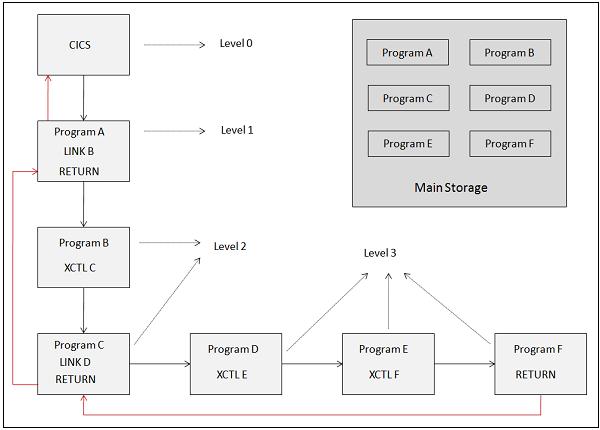
XCTL
The fundamental explanation of XCTL is as follows −
XCTL command is used to pass the control from one program to another at the same level.
It does not expect the control back.
It is similar to GO TO statement.
An XCTL program can be a pseudo-conversational.
Example
The following example shows how to use XCTL command to pass the control to another program −
IDENTIFICATION DIVISION.
PROGRAM-ID. PROG1.
WORKING-STORAGE SECTION.
01 WS-COMMAREA PIC X(100).
PROCEDURE DIVISION.
EXEC CICS XCTL
PROGRAM ('PROG2')
COMMAREA (WS-COMMAREA)
LENGTH (100)
END-EXEC.
This command transfers the control to be passed to program 'PROG2' with 100 bytes of data. COMMAREA is an optional parameter and is the name of the area containing the data to be passed or the area to which results are to be returned.
Link
Link command is used to transfer the control to another program at lower level. It expects the control back. A Linked program cannot be pseudo-conversational.
Example
The following example shows how to use Link command to pass the control to another program −
IDENTIFICATION DIVISION.
PROGRAM-ID. PROG1.
WORKING-STORAGE SECTION.
01 WS-COMMAREA PIC X(100).
PROCEDURE DIVISION.
EXEC CICS LINK
PROGRAM ('PROG2')
COMMAREA (WS-COMMAREA)
LENGTH (100)
END-EXEC.
Load
Load command is used to load a program or a table. Following is the syntax of Load command −
EXEC CICS LOAD
PROGRAM ('name')
END-EXEC.
Release
Release command is used to release a program or a table. Following is the syntax of Release command −
EXEC CICS RELEASE
PROGRAM ('name')
END-EXEC.
Return
Return command is used to return the control to the next higher logical level. Following is the syntax of Return command −
EXEC CICS RETURN
PROGRAM ('name')
COMMAREA (data-value)
LENGTH (data-value)
END-EXEC.
Interval Control Operations
The interval control operations are of the following two types −
ASKTIME
ASKTIME is used to request for current time and date or timestamp. We then move this value to the working storage variable inside the program. Following is the syntax of ASKTIME command −
EXEC CICS ASKTIME
[ABSTIME(WS-TIMESTAMP)]
END-EXEC.
FORMATTIME
FORMATTIME formats the timestamp into the required format based on the options, which can be YYDDD, YYMMDD, or YYDDMM for date. DATESEP indicates the separator for the DATE as does the TIMESEP variable for TIME. Following is the syntax of FORMATTIME command −
EXEC CICS FORMATTIME
ABSTIME(WS-TIMESTAMP)
[YYDDD(WS-DATE)]
[YYMMDD(WS-DATE)]
[YYDDMM(WS-DATE)]
[DATESEP(WS-DATE-SEP)]
[TIME(WS-TIME)]
[TIMESEP(WS-TIME-SEP)]
END-EXEC.
CICS - Temporary Storage
There are different scratch pads which are available in CICS for saving data or to transfer the data between transactions. There are five storage areas which are provided by CICS, which we will be discussing in this module.
COMMAREA
The COMMAREA behaves like a scratch pad that can be used to pass data from one program to another program, either within the same transaction or from different transactions. It should be defined in the LINKAGE SECTION using DFHCOMMAREA name.
Common Work Area
Any transaction in the CICS region can access Common Work Area and hence the format and use of it must be agreed upon by all transactions in the system that decides to use it. There is only one CWA in the entire CICS region.
Transaction Work Area
Transaction Work Area is used to pass data between the application programs that are executed with in the same transaction. TWA exists only for the duration of transaction. Its size is defined in the Program Control Table.
Temporary Storage Queue
Temporary Storage Queue (TSQ) is a feature that is provided by the Temporary Storage Control Program (TSP).
A TSQ is a queue of records that can be created, read and deleted by different tasks or programs in the same CICS region.
A queue identifier is used to identify TSQ.
A record within a TSQ is identified by the relative position known as the item number.
The records in TSQ, remains accessible until the entire TSQ is explicitly deleted.
The records in TSQ can be read sequentially or directly.
TSQs may be written in the main storage or the auxiliary storage in the DASD.
WRITEQ TS
This command is used to add items to an existing TSQ. Also, we can create a new TSQ using this command. Following is the syntax of WRITEQ TS command −
Syntax
EXEC CICS WRITEQ TS
QUEUE ('queue-name')
FROM (queue-record)
[LENGTH (queue-record-length)]
[ITEM (item-number)]
[REWRITE]
[MAIN /AUXILIARY]
END-EXEC.
Following are the details of parameters used in the WRITEQ TS command −
The QUEUE is identified by the name which is mentioned in this parameter.
FROM and LENGTH options are used to specify the record that is to be written to the queue and its length.
If the ITEM option is specified, CICS assigns an item number to the record in the queue, and sets the data area supplied in that option to the item number. If the record starts a new queue, the item number assigned is 1 and subsequent item numbers follow on sequentially.
The REWRITE option is used to update a record already present in the queue.
MAIN / AUXILIARY option is used to store records in main or auxiliary storage. Default is AUXILIARY.
READQ TS
This command is used read the Temporary Storage Queue. Following is the syntax of READQ TS −
Syntax
EXEC CICS READQ TS
QUEUE ('queue-name')
INTO (queue-record)
[LENGTH (queue-record-length)]
[ITEM (item-number)]
[NEXT]
END-EXEC.
DELETEQ TS
This command is used delete the Temporary Storage Queue. Following is the syntax of DELETEQ TS −
Syntax
EXEC CICS DELETEQ TS
QUEUE ('queue-name')
END-EXEC.
Transient Data Queue
Transient Data Queue is transient in nature as it can be created and deleted quickly. It allows only sequential access.
WRITEQ TD
This command is used to write Transient data queues and they are always written to a file. Following is the syntax of WRITEQ TD command −
Syntax
EXEC CICS WRITEQ TD
QUEUE ('queue-name')
FROM (queue-record)
[LENGTH (queue-record-length)]
END-EXEC.
READQ TD
This command is used read the Transient data queue. Following is the syntax of READQ TD −
Syntax
EXEC CICS READQ TD
QUEUE ('queue-name')
INTO (queue-record)
[LENGTH (queue-record-length)]
END-EXEC.
DELETEQ TD
This command is used delete the Transient data queue. Following is the syntax of DELETEQ TD −
Syntax
EXEC CICS DELETEQ TD
QUEUE ('queue-name')
END-EXEC.
CICS - Intercommunication
The mutual communication that takes place between two or more systems is known as intercommunication.
Benefits of Intercommunication
The important benefits of intercommunication are as follows −
We do not need to replicate the data on all the systems.
Users need not hold connections to multiple systems for accessing the data stored on them.
It improves the performance of the application.
Basic Terminologies
One must have a knowledge of basic terminologies used in the CICS system. Following are the basic terms −
Local System
A local system is a system that initiates a request for intercommunication.
Local Resource
A local resource is a resource that lies on the local system.
Remote System
A remote system is a system that is initiated as a result of an intercommunication request.
Remote Resource
A remote resource is a resource that lies on the remote system.
MVS Sysplex
MVS Sysplex is a configuration of multiple MVS operating systems. They work as a single system by sharing functions and programs.
CICSPlex
CICSPlex is commonly described as a set of interconnected CICS regions that process customer workload. A CICSPlex is a set of interconnected CICS regions that own Terminals, Applications, Resources, etc.
Intercommunication Methods
There are two ways in which CICS can communicate with other systems −
MRO − Multi Region Operation is used when two CICS regions within the same MVSPLEX needs to communicate with each other.
ISC − Inter System Communication is used when a CICS region in a LOCAL server has to communicate with a CICS region in the REMOTE server.
CICS - Status Codes
While working with CICS, you may encounter abends. Following are the common abend codes with their description which will help you to resolve the issues −
| Sr.No |
Code & Description |
| 1 |
ASRA
Program Check Exception |
| 2 |
AEI0
Program ID Error |
| 3 |
AEI9
Map Fail condition |
| 4 |
AEIO
Duplicate Key |
| 5 |
AEIN
Duplicate Record |
| 6 |
AEID
End of file reached |
| 7 |
AEIS
File is not open |
| 8 |
AEIP
Invalid request condition |
| 9 |
AEY7
Not authorized to use the resource |
| 10 |
APCT
Program not found |
| 11 |
AFCA
Dataset not found |
| 12 |
AKCT
Time out error |
| 13 |
ABM0
Specified map not found |
| 14 |
AICA
Program in infinite loop |
| 15 |
AAOW
Internal logic error |


